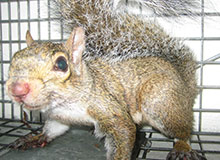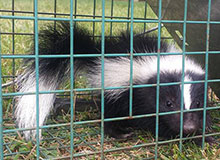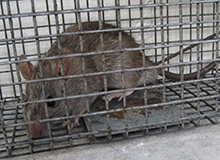Wildlife Trapping Professionals Dallas, Texas
Call us now at (469) 899-5677 for professional wildlife removal services in Dallas, TX.

(469) 899-5677 - Call 24/7
We work 7 days a week - go ahead and call evenings and weekends!
Licensed & Insured
We carry liability insurance and all Texas licenses.
Professional Service
Treating both wildlife and customers with courtesy and respect.
We are a professional animal removal company headquartered in Dallas, and servicing all of Dallas County, TX. We solve problems with wild critters in the home and around the property. We handle animals such as squirrels, raccoons, skunks, rats, mice, opossums, and even snakes,
bats, and birds. We most commonly receive calls about scratching sounds in your attic, or digging in your lawn, or many other critter problems. We not only remove animals, but we provide a wide array of services, from animal damage
repairs, preventative home repairs, attic cleaning, and more. We are fully licensed and insured in Texas, and we answer our phones 24/7. Call us now at (469) 899-5677 for a free price quote and to schedule a same-day or
next day appointment for animal removal.
Our comprehensive services are aimed at eliminating the presence and activities of wildlife on commercial and residential properties permanently. We are a family-run wildlife control company that offers the best quality in the area. We are one of the largest wildlife control companies in the city and are fully licensed and insured for all scales of projects. We apply the most effective technique and provide permanent solutions for our clients. We pride in the application of humane methods in getting rid of all types of critters. We also remove dead animals and are known as top snake removal experts. We will never poison the critters on your property. Instead, we will apply live cage traps and relocate trapped critters far away from your home. The permanent solutions we offer also include exclusion and prevention measures. We get calls from property owners for a wide range of wildlife control problems. Since the effect of wildlife infestation is not seen immediately, property owners and managers contact us when they observe scurrying in the ceilings or walls. We listen to their complaints carefully and describe the course of action. Our services are suitable for immediate use. You can call and schedule our services for the same day or the next day. We will give you a competitive estimate and send expert technicians to your property.
About Our Company

Services We Offer
- Wildlife Trapping
- Prevention Repairs
- Attic Cleanup
Best service in Dallas
- Superior wildlife control from attic to yard, start to finish.
- Available 24/7 with weekend and same-day appointments
- Humane treatment of animals and professional service for you.
Client Testimonials
-
Thank you for coming to my home on a Sunday to get the snake on my porch - I almost had a heart attack before you showed up!
-
Dallas Pest Animal Trapping solved a problem with bats in our building, after two other Texas companies failed - and at a price lower than the others! Thank you!
-
My regular pest control company couldn't get rid of my rat problem - these guys cleaned them out in five days! I've been rat-free ever since!
Dallas Wildlife Trapper Tip of the Month:
Facts About Rat and Mouse Teeth
Rats and mice are rodents that have many similarities, including the same number and type of teeth. In fact, their classification together in the superfamily Muroidea is based on the shape of their lower jaw. Animals that are related to rats and mice but have slightly different teeth are classified outside of the Muroidea superfamily.
The Dental Anatomy of Rat and Mouse
Rats and mouse have enlarged chewing muscles that allow their jaw to work in a vertical, forward and backward motion. Only the front surface of the incisors has enamel, the back is softer dentine. This arrangement allows the continuously growing incisors to remain sharp as they are worn off.
When a rat or mouse gnaws, its lower jaw shifts forward, bringing the incisors into contact with each other and the molars out of contact with each other. The upper incisors hold the object, and the lower incisors cut against it. Hence, only the incisors are involved in gnawing -- molars do not touch each other when a rat gnaws. Most rat and mouse eat a plant-based diet while some enjoy delicacies such as snails, turtles, clams, crayfish, ants and scorpions.

Below are the facts about rat and mouse teeth:
Teeth Color
Rats have dark yellow or orange-yellow incisors. Unlike humans, the yellow color is not an indication of poor dental health; it's caused by a pigment that contains iron and is usually present in greater amounts on the top teeth than the bottom. Mice also have this natural yellow pigment, but it's not as noticeable because their incisors are not as visible as those of a rat.
Teeth Growth
Rat and mouse, just like other rodents, have a set of incisor teeth that never stop growing. Their teeth grow at a rate of 0.3mm a day and about 5 inches per year. Because of this, mice have to constantly gnaw on items which range anywhere from cardboard boxes to wires and furniture in order to grind their teeth down to a reasonable length. Both animals can have serious problems if the incisors get too long. Crooked or misaligned teeth are often the cause of overgrown incisors, but a lack of proper chewing materials can also be to blame.
Monophyodont
Both mice and rats are monophyodont and the teeth that come in when they are babies are the same teeth they will have as adults.
Bruxing
Rats will sometimes grind their teeth from stress or pain, but this behavior typically is to express contentment and relaxation. The behavior is known as bruxing.
Size of Bite
Besides having larger bodies than mice, rats have much larger teeth. If you find objects that have been chewed, you can tell whether it was a rat or a mouse by the size of the tooth marks. Rats leave behind deep marks, usually about 1/8-inch long. Teeth marks made by mice look like tiny scratches on the surface. Their smaller teeth aren't capable of making the same gouges as heavy-duty rat teeth.
Snake Predators: What Animals Eat Snakes?
How Big is a Squirrel Territory? How Far Do Squirrels Travel From Their Nest or For Food?
Humane raccoon removal





